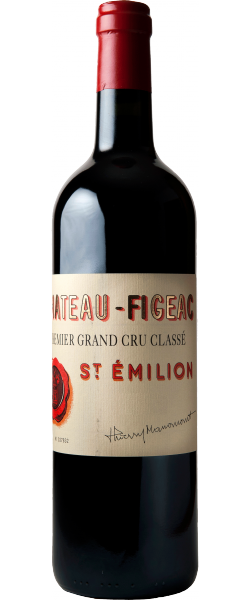
The Estate
Located in the heart of the Saint-Émilion area, a UNESCO World Heritage site, Château-Figeac is the flagship estate of a family that has always been committed to promoting and advancing the region’s prestige and reputation. Spanning 54 hectares (133 acres) in a single sweep, the entire estate has First Growth status, though nearly a quarter is left unplanted with vines in order to preserve a high-quality living environment and an overall natural balance. Here, biodiversity is both self-evident and a long-standing commitment. With its château, its exceptional vinegrowing terroir and its remarkable natural areas, the estate is regarded as the green oasis of Saint-Émilion. Château-Figeac’s vinegrowing terroir is a geological exception for its appellation, with three quartz and flint gravel outcrops, several meters deep, and blue clay subsoil, forming an infinite patchwork of plots planted with the three grape varieties which give the wine its core identity.
From time immemorial, the land and the people of Château-Figeac have played an active part in the life of the City of Saint-Émilion and of the Bordeaux region, whether at the time of Élie de Carle, [“knight of the vines”], in the 18th century or, more recently, of Thierry Manoncourt and his descendants. President of the Jurade de Saint-Émilion brotherhood for 23 years, he travelled all over the world, accompanied by other winegrowers from both Right and Left banks and paved the way for future generations.
Hospitality is a key value at Figeac, along with encouraging winegrowers to share their experience with one another and with academic researchers, and helping to promote the region’s international reputation.
The wine of Château-Figeac gets its character and highly distinctive style from the unique combination of exceptional and complex soils (three Gunzian gravel outcrops, blue clay at depth, a patchwork of plots), several microclimates and an unusual mix of grape varieties dominated by Cabernet Franc and Cabernet Sauvignon. Thierry Manoncourt was the first to plant Cabernet Sauvignon in significant proportions on the Right Bank.
Although the oldest vines date back to 1921, the average age of the vines in the nearly 41 hectare (100 acre) vineyard is 35 years. In recent years, 35% of the vineyard has been replanted while conserving its specific character, following a detailed study of the soil, climate and vegetation.
Practicing massal selection on old vines, the team aim to preserve Château Figeac’s genetic heritage and identity. Our 0.65 hectare (1.5 acre) legacy plot contains a selection of clones of our most remarkable vinestocks of all three grape varieties.
Gravelly soil and Cabernet grapes mean that freshness is inherent in Figeac’s DNA. As a result, Figeac seems well-prepared to withstand the effects of climate change.
The vineyard has also been defined by Château-Figeac’s unique know-how, in symbiosis with its ecosystem.
Rooted in simplicity and nourished by ambition, the prevailing mindset is guided by constant questioning and a desire to innovate in order to ensure the quality and uniqueness of our wines.
Certification is a logical extension of the mindset of the Manoncourt family and those who work for them, acutely aware of the environmental value of the estate as an ecosystem to be protected. Thierry Manoncourt loved being able to “observe these signs of life, large and small, that we protect but do not control”.
In 2013, the 54 hectares (133 acres) were listed as a “natural wildlife reserve”. Château-Figeac committed to ISO 14001 certification in 2015 under the first Environmental Management System for the Bordeaux vineyard. The company has Level 3 HVE High Environmental Value certification.
Château-Figeac also carries out a host of initiatives to study and protect biodiversity, especially bats, bees and pollinating insects, and has set up partnerships with organizations like the French League for the Protection of Birds, the national agricultural research institute INRA and the Chambers of Agriculture network.

Château Figeac Saint-Émilion 1er Grand Cru Classé
Owner: The Manoncourt family since 1892.
Surface Area: 54 hectares (133 acres) in a single block, all First Classified Growth.
Vineyard Area: 41 hectares (101 acres) under vines.
Average Production: Approx. 120,000 bottles of Château-Figeac/year, 40,000 for Petit-Figeac (second wine).
Label: An iconic label, created in 1906 by Thierry Manoncourt’s uncle.
Soil: 3 Gunzian gravel outcrops (altitude 39m, depth. approx. 7m). Flint and quartz on blue clay.
Grape Varieties: Unusual varietal mix in which Cabernet Sauvignon predominates: Cabernet Sauvignon, Cabernet Franc and only 1/3 Merlot.
Average Age of the Vines: 35 years old. The oldest vines in production are Merlots planted in 1921.
Average Yield: 40hl/ha
Viticulture: Sustainable. Certification and commitments to the environment: ISO 14001 certification in 2015 under the first Environmental Management System for Bordeaux vineyards; Level 3 HVE High Environmental Value certification. Registered as a wildlife reserve since 2013.
Harvest: Grapes harvested by hand.
Vinification: Traditional and intra-plot vinification using a gravity-feed process.
Aging: 100% in new oak barrels, 15 to 18 months
Consultant Winemaker: Michel Rolland


